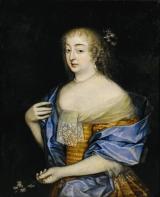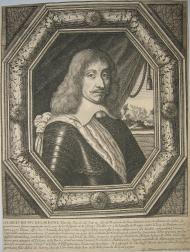Van wie was Marie De Rohan, Duchess Of Chevreuse?
Henry Rich, 1st Earl of Holland dateerde van Marie De Rohan, Duchess Of Chevreuse van ? tot ?.
Charles de l'Aubespine, marquis de Châteauneuf dateerde van Marie De Rohan, Duchess Of Chevreuse van ? tot ?.
Henri de Talleyrand-Périgord, comte de Chalais dateerde van Marie De Rohan, Duchess Of Chevreuse van ? tot ?.
Charles IV of Lorraine dateerde van Marie De Rohan, Duchess Of Chevreuse van ? tot ?. Het leeftijdsverschil was 3 jaar, 4 maanden en 4 dagen.
Alexandre de Campion dateerde van Marie De Rohan, Duchess Of Chevreuse van ? tot ?.
Athos dateerde van Marie De Rohan, Duchess Of Chevreuse van ? tot ?.
Aramis dateerde van Marie De Rohan, Duchess Of Chevreuse van ? tot ?.
Marie De Rohan, Duchess Of Chevreuse

Henry Rich, 1st Earl of Holland

Henry Rich, 1st Earl of Holland (baptised 15 August 1590, died 9 March 1649), was an English courtier and politician executed by Parliament after being captured fighting for the Royalists during the Second English Civil War. Younger brother of Robert Rich, 2nd Earl of Warwick, a Puritan activist and commander of the Parliamentarian navy during the Wars of the Three Kingdoms, Henry was better known as an "extravagant, decorative, quarrelsome and highly successful courtier".
A close friend of Charles I and his favourite the Duke of Buckingham, Rich performed various diplomatic errands, including negotiations for Charles' marriage to Henrietta Maria of France in 1625. He took part in the unsuccessful attack on Saint-Martin-de-Ré in 1627 and held a number of important positions at court during the 1630s. When the First English Civil War began in August 1642, Rich remained in London rather than joining the Royalists, but like other moderates became disillusioned with the war. He defected in July 1643 after failing to persuade his cousin and commander-in-chief of the Parliamentarian army, Robert Devereux, 3rd Earl of Essex, to negotiate peace terms.
When Charles agreed a truce with the Catholic Confederation in September 1643, Rich returned to London and narrowly escaped being tried for treason. After peace talks between Charles and Parliament broke down in late 1647, he fought for the Royalists in the Second English Civil War and was captured in July 1648. Having escaped trial previously, he was executed in March 1649, although Rich claimed he had always been faithful to Parliament and never changed the "principles that ever I professed". This was a view shared by many Parliamentarian moderates, particularly after the Execution of Charles I in January 1649.
Lees meer...Marie De Rohan, Duchess Of Chevreuse

Charles de l'Aubespine, marquis de Châteauneuf

Charles de l'Aubespine, marquis de Châteauneuf (22 February 1580 – 26 September 1653) was a French diplomat and government official.
The marquis de Châteauneuf was the grandson of Claude de l'Aubespine, baron de Châteauneuf. He was made an abbé. He was French ambassador in Holland (1609), in the Habsburg Netherlands (1611–1616), in the Valtellina (1626), and in England (1629–1630).
He then served as the Keeper of the Seals (minister of justice) from 1630, when he replaced Michel de Marillac, until 1633. During that time he was a member of the extraordinary commission that condemned to death the marshal Louis de Marillac and Henri, duc de Montmorency. He conspired with the duchesse de Chevreuse against Cardinal Richelieu (1633), and was deprived of his office and imprisoned in the castle of Angoulême where he stayed for ten years.
Released at the death of Louis XIII, he conspired again against Cardinal Mazarin in the cabale des Importants, 1643. He was appointed again as Keeper of the Seals from 1650 to 1651.
He died at the château de Leuville (Essonne département) in 1653.
Lees meer...Marie De Rohan, Duchess Of Chevreuse

Henri de Talleyrand-Périgord, comte de Chalais

Henri de Talleyrand-Périgord, comte de Chalais (1599–1626) was a favorite of Louis XIII.
He was born in 1599 as son to Daniel de Talleyrand-Périgord, Prince de Chalais and Françoise de Montluc, daughter of Maréchal de Montluc. He started to serve in the military early in his life. He was at the Siege of Montauban in 1621. He became Head of the King's Wardrobe to King Louis XIII.
He married Charlotte de Castille and fought and killed her lover in a duel.
He was accused of conspiracy against Cardinal Richelieu, arrested at Nantes, and beheaded by an unskilled axeman who took over 30 blows to sever the head.
Lees meer...Marie De Rohan, Duchess Of Chevreuse

Charles IV of Lorraine

Carlos IV da Lorena (em francês: Charles IV de Lorraine, em alemão: Karl IV von Lothringen; Nancy, 5 de abril de 1604 - Bernkastel, 18 de setembro de 1675) foi um Duque da Lorena e de Bar, de jure de 1625 a 1675 (de facto de 1625 a 1634, em 1641 e de 1659 a 1670).
Como descendente de Gerardo da Lorena, ele deveria ter sido numerado como Carlos III da Lorena, mas os historiadores lorenos, que pretendiam a legitimidade dos duques da Lorena e de Guise, ligando-os diretamente aos Carolíngios, incluíam na lista de duques o Carolíngio Carlos, duque da Baixa-Lotaríngia, morto em 991.
Lees meer...Marie De Rohan, Duchess Of Chevreuse

Alexandre de Campion
Marie De Rohan, Duchess Of Chevreuse

Athos

Athos is een personage in de romans De drie musketiers, Twintig jaar later, en De burggraaf van Bragelonne van Alexandre Dumas père.
In De drie Musketiers zijn hij en de andere twee musketiers Porthos en Aramis vrienden van het hoofdpersonage van de roman, d'Artagnan. Hij heeft een mysterieus verleden dat hem in verband brengt met de vrouwelijke schurk van de roman, Milady de Winter.
Athos, iets ouder dan de rest, is een vaderfiguur voor de andere musketiers. Hij wordt beschreven als nobel en knap maar ook zeer geheimzinnig, zijn heil in drank zoekend om zijn geheime leed te verzachten en te vergeten.
Op het einde van de roman wordt bekend dat hij in werkelijkheid Graaf van la Fère is, die Milady's echtgenoot was voor ze Graaf de Winter huwde.
In de laatste twee romans staat hij openlijk bekend als Graaf van la Fère en is hij de vader van de jonge held, Raoul de Bragelonne. Net als bij Porthos wordt Athos' voornaam nooit genoemd, al noemt de jonge Milady (toen Charlotte genoemd) hem in het toneelstuk De Jeugd van de Musketiers Vicomte de la Fère Olivier, dus men kan aannemen dat dit Athos' voornaam is.
De fictieve Athos is genoemd naar de historische musketier Armand de Sillègue d'Athos d'Autevielle (1615-1644). Op de naam na hebben ze echter niet veel gemeen. Deze kwam om bij een duel, nog voordat Charles de Batz-de Castelmore (de persoon waarop d'Artagnan gebaseerd is) zich aansloot bij de musketiers; ze zullen elkaar waarschijnlijk dus nooit ontmoet hebben. Zijn titel, Comte de La Fère (Graaf van La Fère) is weliswaar verzonnen, maar verwijst naar de domeinen van La Fère die eens eigendom waren van Anna van Oostenrijk, koningin van Frankrijk in deze romans.
Lees meer...Marie De Rohan, Duchess Of Chevreuse

Aramis

Aramis est un personnage de fiction créé par Alexandre Dumas dans son roman Les Trois Mousquetaires et inspiré d'Henri d'Aramitz.
L’Aramis d'Alexandre Dumas ne doit, semble-t-il, à celui de l’Histoire (Henri d'Aramitz, dont on ignore les dates de naissance et de mort, Aramits étant un village béarnais) que son nom et l’idée d’une vocation ecclésiastique.
Lees meer...